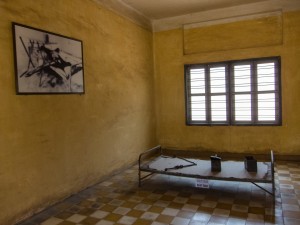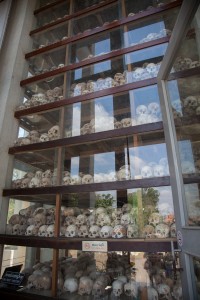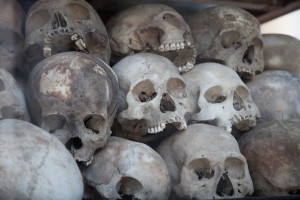 Phnom Penh has been the capital of Cambodia since the country was colonized by the French. In the 1920’s, it was known as the “Pearl of Asia” and was considered one of the prettiest French-built cities in Indochina. It’s a significant tourist destination these days, but people aren’t going to Phnom Penh to gawk at the crumbling French architecture. Rather, there are two gruesome sites that are drawing in the tourists, and we were no exception, making us an unwitting participant in what has in recent years been called “genocide tourism”, or “dark tourism”.
Phnom Penh has been the capital of Cambodia since the country was colonized by the French. In the 1920’s, it was known as the “Pearl of Asia” and was considered one of the prettiest French-built cities in Indochina. It’s a significant tourist destination these days, but people aren’t going to Phnom Penh to gawk at the crumbling French architecture. Rather, there are two gruesome sites that are drawing in the tourists, and we were no exception, making us an unwitting participant in what has in recent years been called “genocide tourism”, or “dark tourism”.
The Tuol Sleng Museum of Genocide, or as it is more commonly known, S-21 used to be a high school until the Khmer Rouge turned it into a torture, interrogation and execution center in 1976 when they came to power after years of civil war and strife. Of the over 14,000 people who entered, only seven survived. The Khmer Rouge were methodical record keepers, transcribing each prisoner’s interrogation session as well as carefully photographing the vast majority of the inmates, establishing an astonishing photographic archive of their crimes. 6,000 of these photographs have been recovered and many are now on display at the Museum, each one a story of shock, resignation, confusion, defiance and horror.
As you approach the museum, it is hard to prepare yourself for what you are about to experience. The museum is located in a lively, noisy neighbourhood but once you walk through the gates into the former school yard, an eerie silence permeates the grounds. At first glance, it looks like any high school – five buildings facing a grass courtyard that has pull up bars, green lawns, and lawn bowling pitches. But then you walk through the buildings and what you see is such an affront to your senses that it renders you speechless. People pass through the three storey buildings in a hushed quiet, whispering expressions of shock and horror to those near them.
 In the first building, the rooms remain as they were found: each classroom was transformed into an interrogation/torture cell that contained a table and chair opposite a metal cot with shackles at each end. On the wall is a photograph of the last victim who occupied the bed, often with pools of wet blood underneath; the photo was taken by the two Vietnamese photojournalists who discovered S-21 in January 1979.
In the first building, the rooms remain as they were found: each classroom was transformed into an interrogation/torture cell that contained a table and chair opposite a metal cot with shackles at each end. On the wall is a photograph of the last victim who occupied the bed, often with pools of wet blood underneath; the photo was taken by the two Vietnamese photojournalists who discovered S-21 in January 1979.
 Another building displays hundreds of haunting photos of the victims who passed through this place during the three years the Khmer Rouge were in power. One photo stands out, a young mother holding her infant child in her arms, with an expression of hopeless but defiant resignation in her eyes – she seems to know what awaits her and her baby.
Another building displays hundreds of haunting photos of the victims who passed through this place during the three years the Khmer Rouge were in power. One photo stands out, a young mother holding her infant child in her arms, with an expression of hopeless but defiant resignation in her eyes – she seems to know what awaits her and her baby.
 Barbed wire still covers the front of another building, used to ensure prisoners could not commit suicide by jumping from the third floor. By the time I reached this building, I must admit I could not enter it. I had seen enough, heard enough, witnessed enough.
Barbed wire still covers the front of another building, used to ensure prisoners could not commit suicide by jumping from the third floor. By the time I reached this building, I must admit I could not enter it. I had seen enough, heard enough, witnessed enough.
The so-called confessions of prisoners are displayed in another building along with the prisoner’s photo. Once sufficient self-confessed evidence of being a traitor or a spy was extracted from a victim usually after long periods of brutal torture and deprivation, they were trucked out to Choeung Ek at night where they were killed.
 A memorial has been established at Choeung Ek which is now known as the Choeung Ek Memorial, the second site we visited during our trip to Phnom Penh. This area, located about 20 km south of Phnom Penh, became one of the most infamous killing fields during the Khmer Rouge regime. More than 17,000 men, women and children were brutally executed here, often after suffering through interrogation, torture and deprivation at the S-21 Prison.
A memorial has been established at Choeung Ek which is now known as the Choeung Ek Memorial, the second site we visited during our trip to Phnom Penh. This area, located about 20 km south of Phnom Penh, became one of the most infamous killing fields during the Khmer Rouge regime. More than 17,000 men, women and children were brutally executed here, often after suffering through interrogation, torture and deprivation at the S-21 Prison.
 Today, the area is a tranquil, park-like setting where paths lead you around the mass graves, killing areas and a memorial stupa that contains thousands of human skulls and bones. The provided audio guide was one of the best we have heard. Narrated by a local Cambodian man who lived and survived the three years of terror during which the Khmer Rouge killed about a quarter of the population. Small signs stand where there were once buildings, and at each one, the audio guide explains what the building was used for. We learned about the way prisoners were processed and then brutally murdered – why waste a precious bullet when a hammer, or garden tool would accomplish the same goal. We saw the tree against which babies’ heads were smashed before being tossed into the neighbouring pit. Their rationale for killing innocent children and babies was that it was better to exterminate an entire family so there would be no one left to seek revenge.
Today, the area is a tranquil, park-like setting where paths lead you around the mass graves, killing areas and a memorial stupa that contains thousands of human skulls and bones. The provided audio guide was one of the best we have heard. Narrated by a local Cambodian man who lived and survived the three years of terror during which the Khmer Rouge killed about a quarter of the population. Small signs stand where there were once buildings, and at each one, the audio guide explains what the building was used for. We learned about the way prisoners were processed and then brutally murdered – why waste a precious bullet when a hammer, or garden tool would accomplish the same goal. We saw the tree against which babies’ heads were smashed before being tossed into the neighbouring pit. Their rationale for killing innocent children and babies was that it was better to exterminate an entire family so there would be no one left to seek revenge.
 The audio tour ends at the Buddhist stupa, a tall pyramid like building with acrylic glass sides, filled with more than 5,000 human skulls that were excavated from the site. There are seventeen shelves of human bones rising to the top of the stupa. Visitors may enter the stupa where you get a very close up view of the shelves of skulls, all of which have been forensically examined and categorized by gender and age. You don’t need to be a forensic scientist to ascertain the cause of death – blunt trauma to the head as evidenced by the cracked or smashed skulls.
The audio tour ends at the Buddhist stupa, a tall pyramid like building with acrylic glass sides, filled with more than 5,000 human skulls that were excavated from the site. There are seventeen shelves of human bones rising to the top of the stupa. Visitors may enter the stupa where you get a very close up view of the shelves of skulls, all of which have been forensically examined and categorized by gender and age. You don’t need to be a forensic scientist to ascertain the cause of death – blunt trauma to the head as evidenced by the cracked or smashed skulls.
It was difficult to visit these two sites. It reminded us of our visit to Germany last fall when we went to the Buchenwald Concentration Camp in Weimar and the Holocaust Memorial in Berlin as well as Israel’s official Holocaust memorial in Jerusalem. Unlike the atrocities committed by Hitler and the Nazis during the Second World War, the Khmer Rouge reigned during the 70’s when I was a teenager. Somehow this hits closer to home for me – the fact that this happened during my lifetime makes me feel so outraged and helpless. I find myself stunned almost beyond feeling when I read and hear of these horrors that man has afflicted on man. It sickens me, and angers me that these things have happened, and that they continue to happen to this day in various parts of the world. How are humans capable of such atrocities?
The whole idea of “genocide tourism” is something new to me and one I will research further. But it has made me ask myself: What compels me to go to these gruesome sites? First it is an education in history, to learn in a powerful way what has happened in the past. Second I see it as a way to show respect for the victims who died here, that they are not forgotten and hopefully have not died in vain. And finally, I hope these sites will jolt us to our senses so that such atrocities will never happen again.





Hi ! Today is my birthday and I got a new Pope! How many people can say that? 🙂
But enough about that, Christina I think this is the most heart felt blog entry since you started… I almost had tears in my eyes at what you might have felt in that place… The feelings it brought are far more touching than the German death camps and the fact that it did happens in our lifetime makes it that much more gut wrenching… I do pray that these atrocities never happens again…
Thanks for sharing it with us even if it is hard to witness.
Marc
Happy Birthday Marc,
Well, a pope for your birthday, that is some gift! It’ll be hard to beat that next year 🙂
It really was emotional visiting those sites in Phnom Penh and then writing about them later brought all the emotion back. Today we met another tuk tuk driver who lived through the Khmer Rouge years…..it is such recent history that everyone we meet has been touched by it! We learned today that even after the Khmer Rouge were ousted by the Vietnamese, they fled to the mountains where they continued to wage a civil war right up until 1998. It’s hard to believe that this country has only enjoyed relative peace for the past fifteen years.
Tomorrow we head to Vietnam and I’m bracing myself for some more painful history lessons.
Christina
Hi Christine,
You did an excellent job of describing these two sites. I felt very much as you did when I was there. I felt compelled to go through there, to learn about atrocities. It has given me a whole new perspective on how cruel humans can be but also how resilient the survivors can be. Our guide told us that, as an eight year old boy, his entire family was killed, and he had to work 18 hours a day in a field, surviving on crickets that he could find to eat. We are so, so sheltered in Canada. Thank you for your raw honesty in describing these sites.
Colleen
Very sad and it hasn’t stopped. There have been and continue to be a number of examples of genocide in our life time. Bosnia, Rwanda, Darfur are recent examples and we’re certain to see more.
Angus